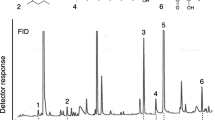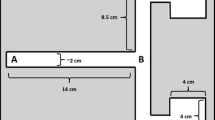Abstract
In choice tests with well-established natural trails and glandular extract trails, allopatric populations of Trinervitermes bettonianus Sjöst followed alien colonies’ trails with the same degree of motivation as their own trails. The five Trinervitermes spp. tested readily followed each other’s trail. Chromatographs of natural trail extracts showed that the main component of the T. bettonianus trail pheromone also occurs in trails of T. gratiosus (and presumably in the other species); this would account for the observed cross-following of trails among these species.
Similar content being viewed by others
References
Howard R. F., Matsumura F. and Coppel H. C. (1976) Trail-following pheromones of the Rhinotermitidae: approaches to their authentication and specificity. J. chem. Ecol. 2, 147–166.
Leuthold R. H. and Lüscher M. (1974) An unusual caste polymorphism of the sternal gland and its trail phero-mone production in the termite Trinervitermes betto-nianus. Insectes soc. 21, 335–341.
Matsumura F., Jewett D. M. and Coppel H. C. (1972) Interspecific response of termites to synthetic trail-following substances. J. econ. Ent. 65, 600–602.
Moore B. P. (1974) Pheromones in termite societies. In Pheromones (Ed. by Birch M. C.), pp. 250–266. North-Holland/American Elsevier, Amsterdam.
Oloo G. W. (1981a) Specificity of termite trails: analysis of natural trails of Trinervitermes. Macrotermes and Odontotermes from sympatric populations. Entomologia exp. appl. 29, 162–168.
Oloo G. W. (1981b) The sternal gland: varíation in size and activity in worker instars of Trinervitermes betto-niamis (Sjöst) (Termitidae). Insect Sci. Applic. 2, 145–147.
Oloo G. W. and Leuthold R. H. (1979) The influence of food on trail-laying and recruitment behaviour in Trinervitermes bettonianus (Sjöst) (Termitidae iNasutitermi-tinae). Entomologia exp. appl. 26, 267–278.
Siegel S. (1956) Non-parametric Statistics for the Behavioural Sciences. McGraw-Hill, New York.
Torgerson R. L. and Akre R. D. (1970) The persistence of army ant chemical trails and their significance in the Ecitonine-Ecitophile association (Formicidae: Ecitonini). Melandria 5, 1–28. In Pheromones (Ed. by Birch M. C.), pp. 222–249. North-Holland/American Elsevier, Amsterdam.
Author information
Authors and Affiliations
Rights and permissions
About this article
Cite this article
Oloo, G.W., McDowell, P.G. Interspecific Trail-Following and Evidence of Similarity of Trails of Trinervitermes Species from Different Habitats. Int J Trop Insect Sci 3, 157–161 (1982). https://doi.org/10.1017/S1742758400005750
Received:
Published:
Issue Date:
DOI: https://doi.org/10.1017/S1742758400005750




